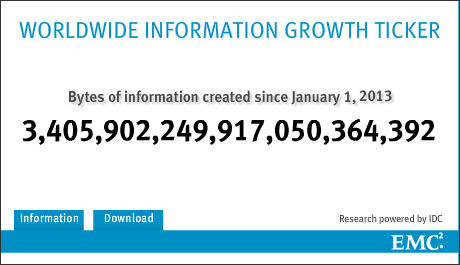eDiscovery Daily Blog
Want to Know How Fast Data is Growing? Get Your Ticker Here – eDiscovery Trends

If you’ve ever been to Manhattan in New York City, you may have seen the National Debt Clock that provides a “ticker” which keeps track of how fast the national debt is growing and each American family’s share of the debt. It’s a sobering number these days. But, did you know there is also a ticker available to show how fast the Digital Universe (of data in the world) is growing?
EMC provides one on their Digital Universe page. The second item on the page is the Worldwide Information Growth Ticker, which shows the bytes of information created since the beginning of the year. The ticker is also downloadable as an Adobe Shockwave file, if you want to keep the ticker on your desktop (and have Shockwave Flash Player installed).
When I checked the ticker yesterday, the number was – wait for it – 3,405,902,249,917,050,364,392 bytes created since January 1. For those that can’t count that high, that’s 3.4 sextillion bytes. Of course, it’s more now.
If you type that number into Excel, it won’t even register correctly. It shows as 3.40590224991705E+21 in the formula and displays the last six digits as all zeroes. With that limitation noted, here is how that number (approximately) equates to different byte measurements:
- 3,326,076,415,934,620,000 kilobytes (KB)
- 3,248,121,499,936,150 megabytes (MB)
- 3,171,993,652,281 gigabytes (GB)
- 3,097,650,051 terabytes (TB)
- 3,025,049 petabytes (PB)
- 2,954 exabytes (EB)
- 2.88 zettabytes (ZB)
Mamma Mia! That’s a lotta bytes! Of course, that’s the digital universe, not raw storage capacity, which is less. However, according to new research from International Data Corporation (IDC), worldwide installed raw storage capacity (byte density) will climb from 2,596 exabytes in 2012 to a staggering 7,235 exabytes in 2017, nearly three times as much in five years. Wow. IDC also provides an infographic analysis of data growth and distribution that is worth checking out.
Of course, just because data is growing at that rate doesn’t mean it’s all original data, so it becomes more important than ever to identify duplicative information via hash deduping, near dupe identification and message thread analysis, so you’re not reviewing the same files over and over again. Nonetheless, the growth of data is noteworthy and I thought the ticker to reflect data growth was pretty cool.
So, what do you think? What do you do to manage data growth within your electronically stored information (ESI)? Please share any comments you might have or if you’d like to know more about a particular topic.
Disclaimer: The views represented herein are exclusively the views of the author, and do not necessarily represent the views held by CloudNine Discovery. eDiscoveryDaily is made available by CloudNine Discovery solely for educational purposes to provide general information about general eDiscovery principles and not to provide specific legal advice applicable to any particular circumstance. eDiscoveryDaily should not be used as a substitute for competent legal advice from a lawyer you have retained and who has agreed to represent you.
